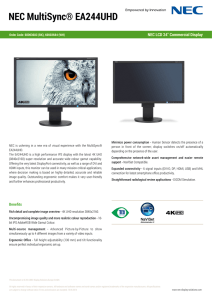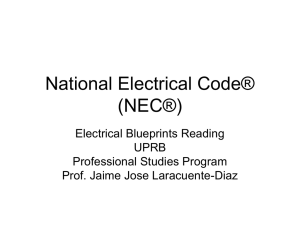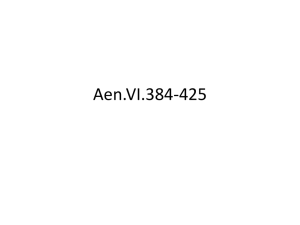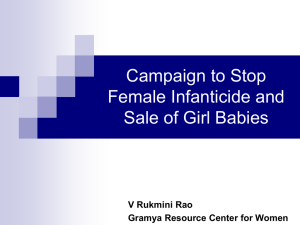PiPS Background: the evidence so far
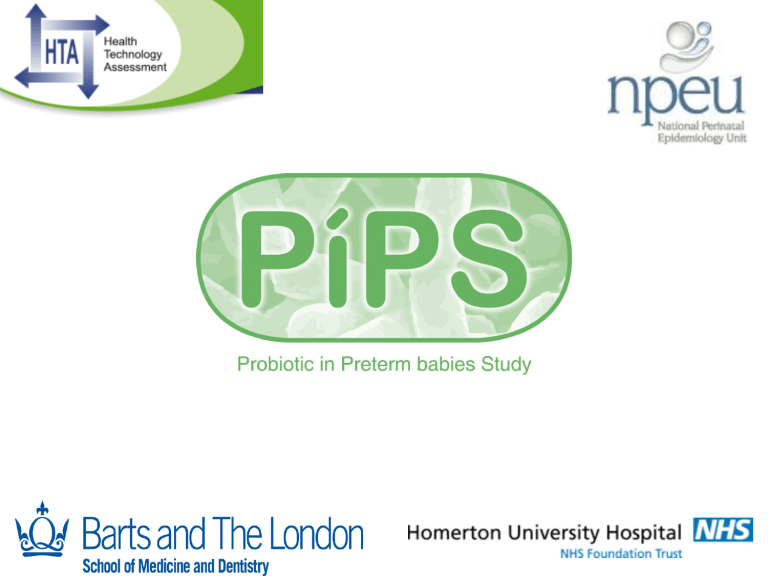
Plan
Background
The evidence so far
Gaps in our knowledge
PiPS
The problem
As survival increases so the proportion of deaths attributed to NEC and infection rises
National data: trends
US ‘linked’ data : singletons
Lucaks SL et al 2004. Peds Inf Dis J.
As survival increases so the proportion of deaths attributed to NEC and infection rises
Primary cause of death
Infection
NEC
1995 2006
8%
4%
16%
12% p
<0.001
<0.0001
RR (95% CI)
1.4 (1.2
1.7 (1.5
– 1.6)
– 1.9)
Source: The EPICure studies
Why probiotics?
Normal development of bowel flora
Sterile at birth …..
Healthy babies colonised rapidly by maternal faecal flora
Flora of breast fed babies dominated by
Bifidobacteria
Benefits of the microbial-host interaction
Benefit Mechanism
Maintain mucosal barrier integrity
Regulate appropriate bacterial colonisation
Activate intestinal immune defences
Modulate intestinal inflammation
•Reduce mucosal permeability
•Increase mucus production
•Strengthen tight junctions
•Inhibit bacterial translocation
•Modulate microflora growth and adherence
•Produce toxins to aerobic bacteria
•Reduce intraluminal pH
•Compete with pathogens for binding sites
•Increase faecal IgA and enhance IgA response
•Produce short chain fatty acids
•Increase leucocyte phagocytosis
•Increase T-cell ¯ophage cytokine production
•Decrease production of anti-inflammatory cytokines
•Decrease proinflammatory cytokines
•Promote Th1 cytokine profile
Martin CR & Walker WA: Seminars in Perinat 2008;
Gut flora in preterm babies
Slower acquisition, further delayed by antibiotics
Less diversity
Fewer commensals
More potentially pathogenic strains
Gewolb IH et al Arch Dis Childh 1999
Probiotic
A live micro-organism which when administered in adequate amounts confers a health benefit on the host (World Health
Organisation, 2010)
Systematic reviews:
Barclay AR et al., JPGN 2007
Deshpande G et al., Lancet 2007
AlFaleh KM & Bassler D, Cochrane 2008
Mihatsch., 2008
Guthmann., 2010
Deshpande G et al., Pediatrics 2010
AlFaleh et al., Cochrane 2011
Systematic reviews:
Barclay AR et al., JPGN 2007
Deshpande G et al., Lancet 2007
AlFaleh KM & Bassler D, Cochrane 2008
Mihatsch., 2008
Guthmann., 2010
Deshpande G et al., Pediatrics 2010
AlFaleh et al., Cochrane 2011
Outcome: ‘Definite’ NEC
Deshpande et al. 2010
Outcome: Blood culture positive sepsis
Deshpande et al. 2010
Outcome: Death
Deshpande et al. 2010
Summary of outcomes
Significant reduction of ‘definite’ NEC
No effect on blood culture positive sepsis
Significant reduction ‘all cause’ mortality
No reported problems with safety
A closer look at those trials designed to study clinical outcomes
Dani C et al 2002
Lin H-C et al 2005
Bin-Nun A et al 2005
Samanta M et al 2008
Lin H-C et al 2008
These studies account for 85% of the babies included in the updated systematic review
Characteristics of clinical studies <2008
Authors
Year
Population
Dani et al
2002
Lin et al
2005
Multicentre
<33w or<1500g n=585
Mean wt >1300g
Single centre
<1500g &>7d
Lines out>24h n=367
Mean wt c.1100g
Bin-Nun et al
2005
Single centre
<1500g starting milk on weekday n=147 (3 not analysed)
Mean wt >1100g
Exclusions
(other than anomalies & refusals)
Intervention
Death <14d Lactobacillus
GG
To discharge
Primary outcome
UTI
NEC ≥stage2
Sepsis all after 7d
Deaths or
NEC in 1 st week
L acidophilus
B infantis
To discharge
Death or
NEC
≥stage
2
No information
B infantis
Str thermophilus
B bifidus
To 36w
Any NEC
Incidence in comparator group
5.2%
2.8%
4.1%
12.8%
(powered at
23%)
16.4%
Characteristics of clinical studies <2008
Authors
Year
Population
Dani et al
2002
Lin et al
2005
Multicentre
<33w or<1500g n=585
Mean wt >1300g
Single centre
<1500g &>7d
Lines out>24h n=367
Mean wt c.1100g
Bin-Nun et al
2005
Single centre
<1500g starting milk on weekday n=147 (3 not analysed)
Mean wt >1100g
Exclusions
(other than anomalies & refusals)
Death <14d
100/685
Deaths or
NEC in 1 st week
48/417
No information
Intervention Primary outcome
Lactobacillus
GG
To discharge
L acidophilus
B infantis
To discharge
UTI
NEC ≥stage2
Sepsis all after 7d
Death or
NEC
≥stage
2
5.2%
2.8%
4.1%
12.8%
(powered at
23%)
B infantis
Str thermophilus
B bifidus
To 36w
Any NEC
Incidence in comparator group
16.4%
Characteristics of 2 recent studies
Authors
Year
Samanta et al
2008
Population
Single centre
<32w &<1500g
Survived 48h
Mean wt >1100g
Exclusions
(other than anomalies & refusals)
Deaths due to ‘other neonatal illness’:
Lin et al
2008
Multicentre
<34w &<1500g
& enterally fed
Asphyxia
Formula fed
Comg anolmaly
NBM >3w
Intervention Primary outcome
Incidence in comparator group
B infantis
B bifidum
B longum
L acidophilus
To discharge
L acidophilus
B bifidum
For 6w
NEC ≥2
Sepsis
Death due to
NEC or sepsis
15.8%
29.5%
14.7%
Death or
NEC≥2 in the
6w study period
9.2% (was powered at
25%)
Characteristics of 2 recent studies
Authors
Year
Samanta et al
2008
Lin et al
2008
Population
Single centre
<32w &<1500g
Survived 48h
Mean wt >1100g
Multicentre
<34w &<1500g
& enterally fed
Exclusions
(other than anomalies & refusals)
Deaths due to ‘other neonatal illness’:
88/274
Asphyxia
Formula fed
Comg anolmaly
NBM >3w
137/580 , 98 of whom died
Intervention
B infantis
B bifidum
B longum
L acidophilus
To discharge
L acidophilus
B bifidum
For 6w
Primary outcome
NEC ≥2
Sepsis
Death due to
NEC or sepsis
Death or
NEC≥2 in the
6w study period
Incidence in comparator group
15.8%
29.5%
14.7%
9.2% (was powered at
25%)
Published studies: general comments
Only 5 of 11 trials were designed to study clinical outcomes
Have only recruited babies receiving milk feeds
Not easy to separate out the smaller more immature babies
No study has undertaken stool microbiology to determine whether the babies are successfully colonised and how much cross-contamination is occurring
All use different products none of which is quality controlled
Safety
None of the published studies reports any complications
Published reports of lactobacilli and one case report of B breve septicaemia
Increased mortality associated with probiotic use in adults with acute pancreatitis,
Besselink MGH et al., Lancet 2008.
The babies at highest risk of NEC and possibly of adverse effects have been excluded from the studies.
Major outstanding questions
Will probiotics reduce NEC and death in an unselected group of very preterm babies?
Why are probiotics apparently ineffective at preventing sepsis?
Is it necessary to give a multi-strain preparation to gain benefit?
Is it safe to give probiotics to the babies at highest risk of NEC?
Objective
To determine whether early administration of Bifidobacterium breve strain BBG to preterm infants reduces the incidence of infection, necrotising enterocolitis and death.
Why is PiPS different?
It is statistically powered to study all three outcomes
Uses a more stringent definition of sepsis for the primary outcome
It has few exclusions and includes babies at high risk of NEC
The intervention is started early whether or not milk feeds have been started
The intervention is a single bacterial strain manufactured to high specification and with a CTA
Stool colonisation with the probiotic bacterium and the effect on intestinal flora will be studied
What will PiPS deliver?
Clarity as to whether B breve BBG prevents death,
NEC and blood culture positive sepsis and whether it is safe in a high risk population of babies
Unique insight into the importance of ‘colonisation’ as opposed to simple ‘administration’ of probiotic on efficacy
Unique insight into the implications of probiotic usage on a Neonatal Unit for those babies for whom it is not prescribed
Trial design
Double blind placebo controlled randomised trial
Primary outcomes
Any baby with an episode of blood stream infection, with any organism other than a skin commensal, diagnosed on a sample drawn more than 72h after birth and before death or discharge.
NEC, Bell stage II or III
Death before discharge
Secondary outcomes
A range of infective outcomes including CONs and numbers of septic screens and stool colonisation
Use of antimicrobials
Time to full feeds and growth
BPD, ROP, IVH etc.
Length of stay
Economic evaluation
Eligibility criteria
≤30w +6d at birth
<48h after birth
Written informed consent
Exclusion criteria
Lethal congenital malformation known at trial entry
Any known g-i malformation
No realistic chance of survival
Babies on antibiotics for suspected or proven infection are eligible for recruitment
Interventions
Active
Bifidobacterium breve strain BBG freeze dried with corn starch re-suspended in 3ml
1/8 th strength Neocate: Iml (2.7
± 0.5x10
9 cfu) to be given once a day starting ASAP after randomisation and continued to 36w postmenstrual age.
Placebo
Freeze dried corn starch alone prepared and administered in the same way.
Participating staff receive training about the trial, making up the intervention and completing the data collection forms
There is emphasis on avoiding cross colonisation of the placebo group with the administered probiotic strain
Clinical management
Feeding and all aspects of management, including the decision to omit a dose of the intervention, are at the discretion of the local clinicians
Data collection
Data collection is paper based and continues till discharge from hospital
Details of microbiology samples, positive cultures and details of antibiotic sensitivities are collected directly from laboratories
Sample collection
2 stool samples; as close as possible to
2w post-natal and 36w post-menstrual age
These samples are posted in a special container to the microbiology laboratory at the Royal London Hospital
No other additional samples are required
Power calculations and statistical significance
The incidence of all 3 primary outcome measures is estimated at around 15%
A trial of 1,300 babies will have 90% power to detect a 40% reduction in relative risk from 15 to
9%. Likewise if the incidence is nearer 12% we will still have 90% power to detect a 44% RR reduction from 12 to 6.7% and from 10 to 5.6%
For the primary outcomes a 95% Confidence
Interval will be calculated; because there are a number of secondary outcomes 99% will be used
Analyses
Comparative analyses will be by Intention to Treat
The following pre-specified sub-groups will be analysed: gestation as per minimisation, male v. female, whether randomised in the first or second
24h
A secondary analysis of all clinical and microbiological outcomes will be conducted by whether the baby was colonised with B breve BBG
Logistic regression analysis will be used to study determinants of successful colonisation with B breve
BBG in the active intervention group
Time-line
The aim is to recruit 1300 babies over a 2.5 year period
Practicalities of achieving target recruitment rates
NHS R&D approval
Adequate numbers of staff on the ground with GCP training who can take consent
Approvals in ‘networked’ hospitals so that babies can continue the intervention until
36w pma after returning to the referring hospital
Summary
Probiotics are the current best bet for a preventive intervention against NEC and are probably safe
We do not know which organism to use and which babies to give it to
PiPS is designed to fill some of the important gaps in our current knowledge




